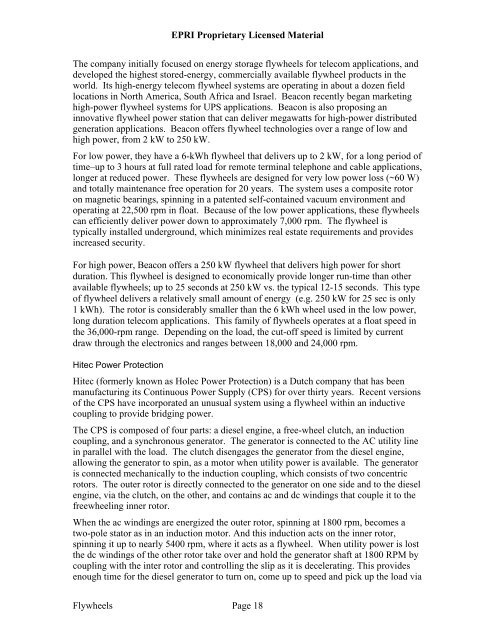Handbook of Energy Storage for Transmission or ... - W2agz.com
Handbook of Energy Storage for Transmission or ... - W2agz.com
Handbook of Energy Storage for Transmission or ... - W2agz.com
Create successful ePaper yourself
Turn your PDF publications into a flip-book with our unique Google optimized e-Paper software.
EPRI Proprietary Licensed Material<br />
The <strong>com</strong>pany initially focused on energy st<strong>or</strong>age flywheels <strong>f<strong>or</strong></strong> tele<strong>com</strong> applications, and<br />
developed the highest st<strong>or</strong>ed-energy, <strong>com</strong>mercially available flywheel products in the<br />
w<strong>or</strong>ld. Its high-energy tele<strong>com</strong> flywheel systems are operating in about a dozen field<br />
locations in N<strong>or</strong>th America, South Africa and Israel. Beacon recently began marketing<br />
high-power flywheel systems <strong>f<strong>or</strong></strong> UPS applications. Beacon is also proposing an<br />
innovative flywheel power station that can deliver megawatts <strong>f<strong>or</strong></strong> high-power distributed<br />
generation applications. Beacon <strong>of</strong>fers flywheel technologies over a range <strong>of</strong> low and<br />
high power, from 2 kW to 250 kW.<br />
F<strong>or</strong> low power, they have a 6-kWh flywheel that delivers up to 2 kW, <strong>f<strong>or</strong></strong> a long period <strong>of</strong><br />
time–up to 3 hours at full rated load <strong>f<strong>or</strong></strong> remote terminal telephone and cable applications,<br />
longer at reduced power. These flywheels are designed <strong>f<strong>or</strong></strong> very low power loss (~60 W)<br />
and totally maintenance free operation <strong>f<strong>or</strong></strong> 20 years. The system uses a <strong>com</strong>posite rot<strong>or</strong><br />
on magnetic bearings, spinning in a patented self-contained vacuum environment and<br />
operating at 22,500 rpm in float. Because <strong>of</strong> the low power applications, these flywheels<br />
can efficiently deliver power down to approximately 7,000 rpm. The flywheel is<br />
typically installed underground, which minimizes real estate requirements and provides<br />
increased security.<br />
F<strong>or</strong> high power, Beacon <strong>of</strong>fers a 250 kW flywheel that delivers high power <strong>f<strong>or</strong></strong> sh<strong>or</strong>t<br />
duration. This flywheel is designed to economically provide longer run-time than other<br />
available flywheels; up to 25 seconds at 250 kW vs. the typical 12-15 seconds. This type<br />
<strong>of</strong> flywheel delivers a relatively small amount <strong>of</strong> energy (e.g. 250 kW <strong>f<strong>or</strong></strong> 25 sec is only<br />
1 kWh). The rot<strong>or</strong> is considerably smaller than the 6 kWh wheel used in the low power,<br />
long duration tele<strong>com</strong> applications. This family <strong>of</strong> flywheels operates at a float speed in<br />
the 36,000-rpm range. Depending on the load, the cut-<strong>of</strong>f speed is limited by current<br />
draw through the electronics and ranges between 18,000 and 24,000 rpm.<br />
Hitec Power Protection<br />
Hitec (<strong>f<strong>or</strong></strong>merly known as Holec Power Protection) is a Dutch <strong>com</strong>pany that has been<br />
manufacturing its Continuous Power Supply (CPS) <strong>f<strong>or</strong></strong> over thirty years. Recent versions<br />
<strong>of</strong> the CPS have inc<strong>or</strong>p<strong>or</strong>ated an unusual system using a flywheel within an inductive<br />
coupling to provide bridging power.<br />
The CPS is <strong>com</strong>posed <strong>of</strong> four parts: a diesel engine, a free-wheel clutch, an induction<br />
coupling, and a synchronous generat<strong>or</strong>. The generat<strong>or</strong> is connected to the AC utility line<br />
in parallel with the load. The clutch disengages the generat<strong>or</strong> from the diesel engine,<br />
allowing the generat<strong>or</strong> to spin, as a mot<strong>or</strong> when utility power is available. The generat<strong>or</strong><br />
is connected mechanically to the induction coupling, which consists <strong>of</strong> two concentric<br />
rot<strong>or</strong>s. The outer rot<strong>or</strong> is directly connected to the generat<strong>or</strong> on one side and to the diesel<br />
engine, via the clutch, on the other, and contains ac and dc windings that couple it to the<br />
freewheeling inner rot<strong>or</strong>.<br />
When the ac windings are energized the outer rot<strong>or</strong>, spinning at 1800 rpm, be<strong>com</strong>es a<br />
two-pole stat<strong>or</strong> as in an induction mot<strong>or</strong>. And this induction acts on the inner rot<strong>or</strong>,<br />
spinning it up to nearly 5400 rpm, where it acts as a flywheel. When utility power is lost<br />
the dc windings <strong>of</strong> the other rot<strong>or</strong> take over and hold the generat<strong>or</strong> shaft at 1800 RPM by<br />
coupling with the inter rot<strong>or</strong> and controlling the slip as it is decelerating. This provides<br />
enough time <strong>f<strong>or</strong></strong> the diesel generat<strong>or</strong> to turn on, <strong>com</strong>e up to speed and pick up the load via<br />
Flywheels Page 18














